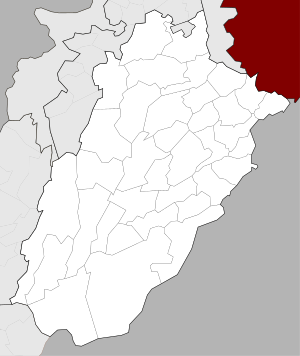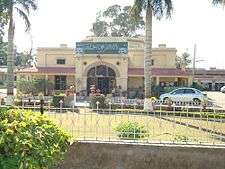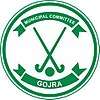Gojra
| Gojra گوجرہ | ||
|---|---|---|
|
| ||
| ||
 Gojra Location within Pakistan  Gojra Gojra (Pakistan) | ||
| Coordinates: 31°9′N 72°41′E / 31.150°N 72.683°E | ||
| Country | Pakistan | |
| Province | Punjab | |
| District | Toba Tek Singh District | |
| Established | 1896 | |
| No. of Towns | 1 | |
| Government | ||
| • Union Councils | 24 | |
| Area | ||
| • Total | 431 sq mi (1,115 km2) | |
| Elevation | 1,526 ft (465 m) | |
| Population (1998) | ||
| • Total | 117,892 | |
| • Density | 270/sq mi (110/km2) | |
| • Estimate (2011) | 796,087 | |
| Time zone | UTC+5 (PST) | |
| • Summer (DST) | UTC+6 (PDT) | |
| Zip Code | 36120 | |
| Area code(s) | +9246 | |
| Website |
www | |
Gojra (Punjabi and Urdu: گوجرہ), the administrative capital of Gojra Tehsil, is the city of Toba Tek Singh District in the Punjab in the province of Pakistan.[1] Gojra is 30 miles (50 km) from Faisalabad, 170 km from Lahore, and 20 miles (32 km) north of Toba Tek Singh.[2] Founded in 1896 during the British colonial period, Gojra was the commercial centre of lands which had recently come under cultivation, and was known for its "mandi" (market) for cash crops.
History
Pre-Independence
Gojra city was established in 1896, when the colonisation of Faisalabad began. The railway line between Faisalabad and Gojra was laid in 1899. The town was given the status of notified area committee in 1904 and upgraded to a B-Class Municipality in 1925. In 1906, the population was 2,589, according to The Imperial Gazetteer of India.[2]"The business done in this rising mart on the railway, which has sprung into existence in the last six years owing to the extension of the Chenab Canal to the surrounding country, bides fair to rival in importance that of Faisalabad itself".</ref>
In 1919, following the Rowlatt Act, hartals broke out throughout Punjab. Gojra was affected by serious protests and a member of the Church Mission Society had to be escorted out of the town by loyal residents.[3]
Post-Independence
In August 1947, India and Pakistan achieved independence. Riots and local fighting followed the expeditious withdrawal of the British, resulting in an estimated one million civilians deaths, particularly in the western region of Punjab.[4] Gojra, which was in the region of the Punjab Province that became West Pakistan, was populated by a number of Hindus and Sikhs who migrated to India, while Muslim refugees from India settled in the district.[5]
After independence from Britain, in view of its increasing size, it was declared as a 2nd class Municipal Committee in 1960. Gojra was raised to the status of tehsil town and affiliated with the newly established district Toba Tek Singh on 01.07.1982. After the introduction of Devolution of Powers Plan, the Tehsil Municipal Administration Gojra came into being on 12.08.2001.
Geography
Gojra's coordinates are as UTM: BQ74
Geographical coordinates in decimal degrees (WGS84)
- Latitude: 31.150
- Longitude: 72.683
Geographical coordinates in degrees minutes seconds (WGS84)
- Latitude: 31 09' 00
- Longitude: 72 41' 00
Geology
The district of Toba Tek Singh is part of the alluvial plains between the Himalayan foothills and the central core of the Indian subcontinent. The alluvial deposits are typically over 1,000 feet thick. The interfluves are believed to have been formed during the Late Pleistocene and feature river terraces. These were later identified as old and young floodplains of the Ravi River on the Kamalia and Chenab Plains. The old floodplains consist of Holocene deposits from the Ravi and Chenab rivers.
The soil consists of young stratified silt loam or very fine sand loam that makes the subsoil weak in structure with common kankers at only five feet. The course of the rivers in Faisalabad are winding and often subject to frequent alternations. In the rainy season, the currents are very strong. This leads to high floods in certain areas which last for days.
The Rakh and Gogera canals have encouraged the water levels in the district; however, the belt on the Ravi River has remained narrow. The river bed includes the river channels which have shifted the sandbars and low sandy levees leading to river erosion.
This area is between the Chenab and Ravi rivers. There is a mild slope from the northeast to the southwest with an average fall of 0.2–0.3 metres per kilometre (1.1–1.6 feet per mile). The topography is marked by valleys, local depression and high ground.
Map visualization
Places
Places near Gojra are as follows:
- Amirpur - Bahram - Bambai nawan - Bhukike - Bujianwala
- Burltonpur - Butala - Chahal - Chak 95JB Gill - Chawinda - Duranpur
- Gahri gil - Ghaniake - Gil janubi - Gil sahbu - Goughpur
- Bobak 360jb(1st)
Economy
The surrounding countryside, irrigated by the lower Chenab River, produces cotton, wheat, sugarcane, vegetables and fruits. The city is an industrial centre with major railway yards, engineering works, and mills that process sugar, flour, and oil seed. Gojra is known for producing crops, especially in wheat production, as well as sugarcane and cotton. Gojra has its own fabric mills, which import and export to other countries.
Government and public services
Civic administration

The city was raised to the status of Tehsil town and affiliated with the newly established district Toba Tek Singh on 1 July 1982. After the introduction of the Devolution of Powers Plan, the Tehsil Municipal Administration Gojra came into being on 12 August 2001.[6] The Canal resthouse is the oldest building constructed during British government in 1898.
After Gojra has reached tehsil status:
It has an area of 1,115 km² and is administratively separated into 24 Union Councils. The aim of the city government is to empower politics by improving governance which basically involved decentralising administrative authority with the establishment of different departments and respective department heads, all working under one platform. The stated vision and mission of the city district government of Gojra is to "establish an efficient, effective and accountable city district government, which is committed to respecting and upholding women, men and children's basic human rights, responsive towards people's needs, committed to poverty reduction and capable of meeting the challenges of the 21st century. Our actions will be driven by the concerns of local people."
Municipal administration
TMA Gojra was established in 2001. Under Govt rules it was stated that TMA is responsible for every action in municipal administration. TMA Gojra is currently working efficiently in its specified domain. After independence in view of its increasing size, it was declared a 2nd class Municipal Committee.
The functions of the TMA include preparation of the spatial and land use plans, management of these development plans and exercise of control over land use, land sub-division, land development and zoning by public and private sectors, enforcement of municipal laws, rules and by-laws, provision and management of water, drainage waste and sanitation along with allied municipal services.
Law enforcement
Law enforcement in Gojra is carried out by the city police, under the command of the Punjab police officer, an appointment by the provincial government. The office of the CPO is in the District Courts, Faisalabad. Police formations include district police, elite police, traffic police, Punjab highway patrolling, investigation branch, and special branch.
Demographics
The province of Punjab, in which Gojra is the administrative seat, has prevalent sociocultural distinctions. Population sizes vary by district but some distinguishing factors include a young age structure, high age-dependency ratio, a higher percentage of males, a higher proportion of married population, and heterogeneity in castes and languages.
Islam is the common heritage in the region with a 97.22% Muslim majority according to the 1998 Pakistan census report and 2001 population data sheet. Islamic influences are evident in the fundamental values of inhabitants including cultural traditions, marriage, education, diet, ceremonies and policies that may reflect stark differences in rural villages as compared to urban areas. People live in tight-knit joint families, although a nuclear family system is emerging due to changing socio-economic conditions .
Prevalent minorities, particularly Hindu and Christian, feel a sense of vulnerability because of their religious beliefs. Labourers and farmhands comprise the countless Christian villages throughout Punjab. Many are descendants of people who converted from Hinduism to Christianity under the British Raj and considered low caste by virtue of their birth. A small population of wealthy, well-educated Christians have settled in Karachi; however, as a result of increasing Islamization, religious intolerance in Pakistani society, blasphemy laws and Islamist militancy, most have left Pakistan to settle where there is more religious tolerance, such as Canada and Australia.
The region was the scene of the 2009 Gojra riots in which a series of attacks targeting Christians led to the deaths of eight people including four women and a child.
Education
Gojra is home to the Govt Post Graduate College, The Educators Amna Campus, Knowledge House Institute of Technology,Skyline College for Humanities and Social Sciences, Gojra,Apna School System Gojra Punjab Group of Colleges, Allied Schools (Pakistan) as well as Divisional Public School.
Culture
Festivals
The Punjabi people celebrate cultural and religious festivals throughout the region, such as arts and craft, music, local events, and religious celebrations.
The city of Gojra customarily celebrates its independence day on 14 August by raising the Pakistan flag at every home and important Govt buildings. Bazaars are colourfully decorated for the celebration, government and private buildings are brightly lit, and there are similar flag–raising ceremonies that are typically held in the district and its tehsils.
The arrival of spring brings the annual "Rang-e-Bahar" festival during the month of March, where the Parks & Horticulture Authority of the Gojra Municipal Committee organise a flower show and exhibition at Civil Club, Gojra. [7]
Being a Muslim majority city, religious observances include Ramadan(Ramzan) and Muharram. The festivals of Chaand Raat, Eid al-Fitr and Eid al-Adha are celebrated and are national holidays. The celebration of the Prophet Muhammad birthday is observed in the city which is often referred to as "Eid Milād-un-Nabī". There are darbar and shrines which attract devotees during the annual Urs. There are Christian churches in the city where Easter and Christmas services take place.
Attire
Traditional attire in Gojra is Punjabi clothing such as the dhoti, kurta and pagri. Gojra men wear white shalwar kameez as do women but with a dupatta (scarf). Mostly women wear burqas that may or may not cover the face. Combinations of Pakistani and Western attire are worn by women, such as an embroidered kurta worn with jeans or trousers, and half sleeve or sleeveless shirts with Capri pants. Men have adopted some of the modern Western styles for both casual and formal business dress such as dress pants, trousers, T-shirts and jeans.
Food
Gojra's cuisine is very much Punjabi cuisine, with influences from the times of the Mughal and Colonial empires. Key ingredients include rice or roti (flatbread) served with a vegetable or non-vegetable curry, a salad consisting of spiced tomatoes and onions, and yogurt. This is usually accompanied by South Asian sweets such as jaggery, gajar ka halwa, gulab jamun, and jalebi. Tandoori barbecue specialties consist of naan bread served with tandoori chicken, chicken tikka or lamb shishkebab served with a mint chutney.
Street foods are a key element to cuisine. Samosas (deep fried pastry filled with vegetables or meat) are topped with an onion salad and two types of chutney. Other street foods include dahi bhale (deep fried vadas in creamy yoghurt), gol gappay (fried round puri filled with vegetables and topped with tamarind chutney) and vegetable or chicken pakoras. Biryani and murgh pilao rice are a specialty in Gojra.
A typical breakfast in Gojra is halwa poori comprising a deep-fried flatbread served with a spicy chickpea curry and sweet orange-coloured halwa. It is customarily accompanied by a sweet or salty yoghurt-based drink called lassi. During winter, a common breakfast is roghni naan bread served with paya curry.
Specialty drinks vary depending on climate. During winter, hot drinks are available, such as rabri doodh, a creamy dessert drink commonly made with full-fat milk, almonds, pistachios and basil seeds, dhood patti (milky tea), and Kashmiri chai, a pink coloured milky tea containing almonds and pistachios. During summer, drinks such as sugarcane rusk, limo pani (iced lemon water), skanjvi (iced orange and black pepper) and lassi are common.
Education
Government institutes
Gojra's famous public institutions for higher education:
- Government Postgraduate College
- Government Municipal Degree College
- Government M. C. High School
- Government Islamia High School
- Government Girl High School Bobak
These publicly funded institutions work efficiently in their specified domains. They produce graduates who are skillful and they excel in their fields.
There is a commerce college being run by TEVTA in a specially designed building. It produces graduates which are expert in techniques in educational as well as vocational level.
Private institutes
The city has 344 state-run primary and higher secondary educational institutions.[8] Prominent institutions within the city boundary are
- The Educators Amna Campus.
- Skyline College for Science, Humanities and Social Sciences, Gojra.
- Apna School System Gojra
- Divisional Model College
- The Arqam Schools Gojra
- Shiblee Group of Schools & Colleges Gojra
- The Royal Public Model School Mahdi Bazar Gojra
- The Dawn School
- Al-Islah Model High School Gojra
- Al-Barqat Model High School Pensra Road Gojra
- Allama Iqbal Science College Sumandari Road Gojra
- Punjab College Bypass, Gojra
- Quaid-e-Azam High School
- Muslim College Gojra
- Knowledge House Institute of Technology Pensra Road Gojra
- Jinnah College Gojra
- The Scholars Public Middle School
- Quaid Public High School Bobak Chock
The Punjab Group Of Colleges started classes in 2012 with programs of F.A, F.Sc, I.Cs, I.Com, B.Sc, B.A and B.Com. Gojra Campus of The Punjab Group Of Colleges is on Gojra-Faisalabad Road near bypass stop.
Allied Schools is a school system, a group of schools in Pakistan operating in Gojra. It is working under the Punjab Group of Colleges.
Languages
The population speaks Punjabi as mother tongue while the national language Urdu is widely spoken.
Arabic is taught in Madrasahs and Masjids as a religious language. English as the official language is taught in all schools.
Health
Publicly funded Govt are various hospitals in Gojra. Government funded Govt Eye and General Hospital is also running in this area. This hospital built before Independence, has 150 bed facility. This hospital is very famous in area because of its special eye related services to its patients.
There are various private hospitals in Gojra. They provide quality health treatment to patients.These are specialized in providing primary to specialized health care facilities to its citizens. These hospitals provide beds facility for its patients. In addition, there are also running private welfare institutions with specialized health care.
Sports & Famous Persons
Notable hockey players from Gojra include:
Gojra contributed a number of players to the Pakistan Hockey team.[9][10] In 2015, Gojra Hockey Club, a local club, won the Jat Tar Singh memorial U19 (Under 19) hockey tournament. This high-profile tournament was held in India, where Gojra city team competed again best of Indian U19 hockey teams and won the championship.[11] The Gojra team won this title by defeating Amritsar Academy 4–2 at Ludhiana hockey stadium.
In cricket, Gojra's Ehsan Adil has represented the Faisalabad Wolves, Habib Bank Limited cricket team and Pakistan Under-19 cricket team. He has been selected in Pakistan's Test Squad for tour to South Africa in February 2013.[12]
References
- ↑ T. Singh$d_home&group_type=dist&group_id=332&group_name=T. T. Singh&js_pane=P-1004ba76975-10000&pview=true "Punjab Portal" Check
|url=value (help). Pportal. punjab.gov.pk. 19 September 2011. Retrieved 18 October 2011. - 1 2 "Gojra – Imperial Gazetteer of India, v. 12, p. 306". Dsal. uchicago.edu. Retrieved 18 October 2011.
- ↑ Punjab disturbances, April 1919; compiled from the Civil and Military Gazette. (1919)
- ↑ Crispin Bates, Phd (3 March 2011). "The Hidden Story of Partition and its Legacies". British History. BBC. Retrieved 4 December 2015.
- ↑ Yasmin Khan (2007). The Great Partition: The Making of India and Pakistan. Yale University Press. ISBN 978-0-300-12078-3.
- ↑ Tehsil Administration of Gojra Archived 9 October 2007 at the Wayback Machine.
- ↑ https://www.thenews.com.pk/print/296118-tea-stall-owner-beaten-by-extortionists
- ↑ ":: WELCOME SCHOOL EDUCATION DEPARTMENT ::". schoolportal.punjab.gov.pk. Retrieved 2017-01-25.
- ↑ http://nation.com.pk/national/16-Aug-2012/gojra-has-produced-112-international-hockey-players
- ↑ "Hockey players honoured – Dawn Pakistan". Dawn.com. Retrieved 18 October 2011.
- ↑ "Gojra club wins hockey final in India". App.com.pk. Archived from the original on 13 January 2016. Retrieved 18 October 2011.
- ↑ http://www.espncricinfo.com/pakistan/content/player/547092.html

